 Image search results - "Kono" Image search results - "Kono" |

A group of men carry a red and white pole in front of Inazawa Station, on their way to Konomiya Shrine.
|
|

Raising a pole in front of Inazawa Station
|
|

Raising a pole in front of Inazawa Station
|
|
|

They zig-zag along the street, and they are filled with sake.
|
|
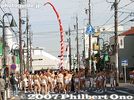
Every once in a while, they raise their pole.
|
|
|

On the straight road from Inazawa Station to Konomiya Shrine.
|
|
|
|
|

Konomiya Shrine torii and the long path to the shrine is lined with a large crowd.
|
|

Numerous groups of near-naked men (no women) proceed to the shrine all afternoon.
|
|
|
|

Zig-zag to the shrine
|
|
|

Another torii
|
|
|
|
|

Romon Gate 楼門
|
|

After passing through this gate, the men enter the shrine grounds. Romon Gate 楼門
|
|

Haiden Hall where the men offer their long poles. 拝殿
|
|

Haiden Hall 拝殿
|
|

Now empty, this path will soon be filled with thousands of men in loincloths.
|
|

Some of the men tear off strips from their handband and give them to bystanders.
|
|

Main guest room
|
|

Gaijin talking to gaijin. Sounded Australian. English teacher at junior high.
|
|

Gaijin girls had an easy time attracting men who happily tried to converse in English and bestow cloth strips.
|
|

The inner path to the shrine gets more crowded.
|
|

It was a pretty cold day, and these men were drinking all afternoon.
|
|
|
|

Banzai cheers when an extra-large pole was brought to the shrine.
|
|

Stacking up the poles.
|
|

Men start to pour into the shrine.
|
|

They are waiting for the Sacred Man.
|
|

Now they start to splash cold water on the men, and some of the spectators.
|
|
|
|

Water supply
|
|
|

Splashing water
|
|

Men with buckets come for a refill.
|
|
|

They get pretty crazy, getting more water.
|
|
|
|
|

Konomiya Hadaka Festival, Inazawa, Aichi Pref.
|
|
|

All the men look in the direction of the Sacred Man.
|
|

All the men look in the direction of the Sacred Man, but few can actually see him or touch him for good luck.
|
|

The Sacred Man struggles to reach the small window.
|
|

The men are shouting "Kami-o Kami-o" (another way of pronouncing the kanji for Kami-otoko). 神男
|
|
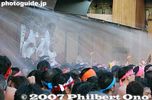
This is the small window the Sacred Man has to enter. It has a sprinkler system.
|
|
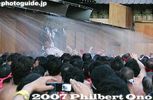
All the men want to touch the Sacred Man, believing that it will dispel bad luck.
|
|

The men in the window give directions to the Sacred Man.
|
|

Sometimes a man from the window jumps into the crowd to grab and take in the Sacred Man.
|
|
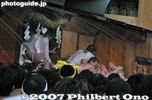
Maybe this is the Sacred Man being pulled into the window.
|
|

When the Sacred Man enters the window, everyone cheers.
|
|

The festival is over.
|
|

The window where the Sacred Man entered.
|
|

Inside the shrine hall.
|
|

TV reporter with this year's Sacred Man (Kami-otoko), Kato Norihiko, from Ichinomiya 神男:加藤 典彦
|
|

TV reporter with this year's Sacred Man (Kami-otoko), Kato Norihiko 神男:加藤 典彦
|
|

Giant kagami mochi, rice cake in the Haiden Hall. Over 2 meters tall and over 2 meters diameter. Weighs 4 tons. They are to be cut into small pieces (with a chain saw) and given away the next morning.
|
|

More giant mochi offered to the shrine. Notice the forklift. 大鏡餅奉納
|
|

Giant mochi inside the Haiden hall. 大鏡餅奉納
|
|

Closeup of giant mochi. Solid as a rock.
|
|

Tree surrounded with cloth strips called Naoi-gire
|
|

Cloth strips (100 yen each) to ward off bad luck 厄除けの ”なおいぎれ” 初穂料 1本 100円
|
|

Hiroshima is also famous for okonomiyaki.
|
|

Moto-Ise Kono Shrine (元伊勢籠神社)Ise Grand Shrines (Ise Jingu) in Mie Prefecture are Japan's most sacred Shinto shrines. They are dedicated to the Sun Goddess Amaterasu (Shinto's most important goddess and legendary ancestor of the Imperial family) and Toyouke-Omikami (豊受大神), goddess of agriculture.
|
|
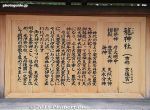
About Moto-Ise Kono Shrine (元伊勢籠神社). Before Ise Jingu was established around the 7th century (or earlier), a number of shrines for these two deities were temporarily or permanently established in various locations including this Kono Shrine. These pre-Ise Jingu shrines are prefixed with "Moto-Ise." Kono Shrine worships five gods and one of them is Toyouke-Omikami (豊受大神), the same goddess of agriculture worshiped in Ise.
|
|
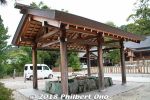
Purify yourself here.
|
|
|
|

Moto-Ise Kono Shrine torii. No photos beyond this torii.
|
|
|
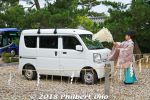
Lucky to see a shrine priest bless a vehicle for traffic safety.
|
|
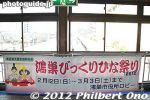
One of Japan's biggest Hina Matsuri doll festivals is held at Konosu, Saitama from mid-February to March 3, Girls' Day. The main site is Konosu City Hall lobby with its huge, 7-meter-high pyramid with over 1,800 hina dolls. Inside Konosu Station
|
|

JR Konosu Station.
|
|

Way to Konosu City Hall, the main site for the Hina Matsuri.
|
|
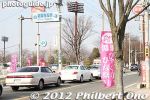
Follow the pink banners. The road is also crowded with cars.
|
|
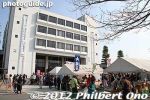
Konosu City Hall. In front are food booths.
|
|

Konosu City Hall front entrance.
|
|
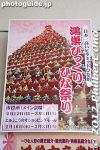
PR poster
|
|
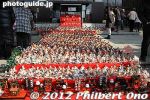
On weekends when it's not raining, they also display 2,000 hina dolls on the front porch.
|
|
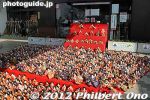
2,000 hina dolls on the front porch of Konosu City Hall.
|
|
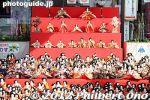
Konosu has a long doll-making history dating back to the Edo Period.
|
|
|
|
|
|
|
|
|
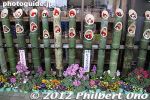
Hina dolls in bamboo.
|
|
|
|
|
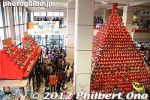
Inside Konosu City Hall is this huge pyramid of hina dolls.
|
|

Konosu Hina Matsuri Doll Festival
|
|
|
|
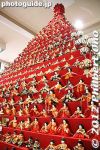
Konosu Hina Matsuri Doll Festival
|
|
|
|
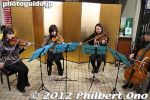
Live musicians play next to the pyramid.
|
|
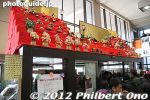
More dolls above the entrance.
|
|
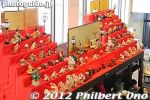
More dolls above the entrance.
|
|
|
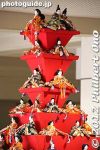
The top dolls are actually screwed on to the pyramid so they won't fall during an earthquake.
|
|
|
|
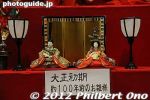
Antique hina dolls were also displayed. These are from the 1920s.
|
|
|
|
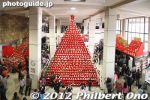
Konosu Bikkuri Hina Matsuri doll festival in Konosu, Saitama.
|
|
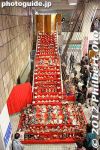
This stairway was also filled with dolls.
|
|
|
|
|
|
|
|
|
|
|
|
|
|
|
|

We could go up to the 2nd floor which was also lined with dolls.
|
|
|
|
|
|
|
|
|
|
|
|
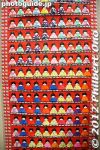
Origami hina dolls
|
|

They also sold local products like honey.
|
|
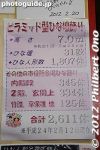
Numeric data on the hina doll pyramid. The pyramid is 7 meters high, has 31 steps and 1,807 dolls.
|
|
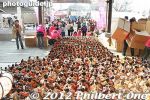
Front porch again.
|
|
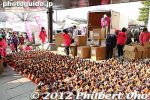
The dolls on the porch are displayed until 3:30 pm. They are now putting away the dolls.
|
|
|
|
|
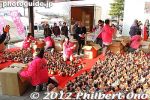
They put away the dolls in no time.
|
|
|

Local mascot.
|
|
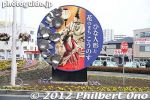
Hina doll monument in front of JR Konosu Station.
|
|
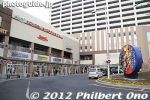
Elumi Konosu Shopping Mall in front of Konosu Station.
|
|

Inside Elumi Konosu Shopping Mall.
|
|
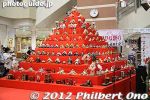
Another festival site is the Elumi Konosu Shopping Mall in front of Konosu Station. They have a smaller pyramid of dolls and stage entertainment on the 1st floor's Central Court.
|
|
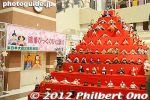
Elumi Konosu Shopping Mall also holds a hina matsuri doll festival with a smaller pyramid.
|
|
|
|
|
|
|
|
|
|
|
|
|
|
|
|
|
|
|
|
|
|
|

Entertainment schedule in front of the doll pyramid.
|
|

Hina Doll Festival schedule.
|
|
|
|
|
|
|
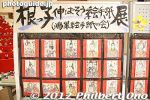
Postcards
|
|
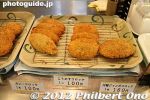
Good place to pick up something to eat at the food court.
|
|

Hyogo Park of the Oriental White Stork has a few buildings amid large rice paddies and mountains.
|
|

Huge rice paddy within Hyogo Park of the Oriental White Stork.
|
|

Rice paddy has a high nesting platform. The nest still intact.
|
|

Spider web.
|
|

Kounotori can also mean "bird bringing happiness." Sculpture related to the bird of happiness. Makes people happy especially when the stork delivers your baby.
|
|

White stork mail box at Oriental White Stork Park in Toyooka, Hyogo.
|
|

Basic map of Hyogo Park of the Oriental White Stork. Only one building on the left is open to the public.
|
|

Gate to Hyogo Park of the Oriental White Stork. Open: 9:00 am–5:00 pm, closed Mondays (open if a national holiday and closed the next day instead), December 28th–January 4th.
|
|

The building in the middle is the University of Hyogo Graduate School of Regional Resource Management.
|
|

On the right is the park's administrative building.
|
|

On the left is the Toyooka Kounotori Bunkakan or Oriental White Stork Culture Center.
|
|

Inside the Oriental White Stork Culture Center. Walk through this building to the other side of the building to see the open cage.
|
|

Toyooka Oriental White Stork Culture Center's open cage for Oriental white storks. It includes paddies used for feeding. The cage is "open" because it only hasa fence and no roof.
|
|

Toyooka Oriental White Stork Culture Center's open cage for Oriental white storks. There are about nine storks in the open cage. Their wings have been clipped to they cannot fly.
|
|

So if you go to Hyogo Park of the Oriental White Stork, you can see real Oriental white storks.
|
|

About the Oriental white stork open cage.
|
|

Around 9:30 am to 10 am, they feed the storks. This is the best time to visit the park. And the best chances of seeing storks flying around.
|
|

They are throwing small dead fish into the paddies.
|
|

The storks are carnivores, feeding on fish, frogs, snakes, rabbits, mice, etc.
|
|

The Oriental white stork has black and white wings and a black bill.
|
|
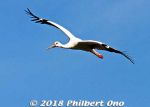
The Oriental white stork is a big, beautiful bird often mistaken as the Japanese crane. Wingspan is 2 meters.
|
|

Once found all over Japan, the Oriental white stork ("kounotori" in Japanese) became extinct in the wild in Japan in 1971 despite preservation efforts since 1955.
|
|

Toyooka was where the last living Oriental white stork in Japan died in 1986. Pesticides in rice paddies (where they feed) and other environmental problems caused their demise.
|
|

In 1985, six wild Oriental white stork chicks from the USSR (Khabarovsk) were acquired to be raised in Toyooka. From 1989, the birds from Russia started to breed successfully in captivity in Toyooka every year.
|
|

From 2005, the park started releasing Oriental white storks into the wild in Toyooka, which was a great celebration. The birds then started to breed and reproduce in the wild.They've been releasing only a few birds (fewer than 5) almost every year.
|
|

As of Oct. 2018, Japan has over 140 Oriental white storks in the wild. They are also successfully breeding in Tokushima, Shimane, and Kyoto Prefectures. It's still an endangered species, with only slightly over 2,000 of them in the Far East.
|
|
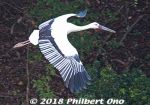
I didn't expect to see the storks flying around, so I was thrilled when a few of them flew overhead while I was in the park. They flew in during feeding time.
|
|
|
|
|
|
|
|
|
|
|
|

They make a loud clacking noise with their bills.
|
|
|
|
|
|
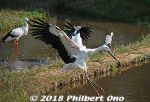
White stork landing in the paddy during feeding time.
|
|

Feeding time for the storks also attracts unwanted birds like black kites. They swoop in and steal a fish, then don't come back.
|
|
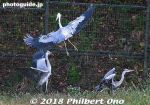
Grey herons also drop by, but they are always fighting each other.
|
|
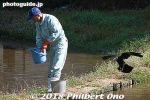
Crows also drop by.
|
|

Storks swallow the fish whole.
|
|
|
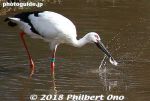
Oriental white stork eating a fish.
|
|
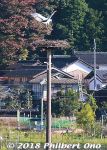
Landing on a nesting platform.
|
|
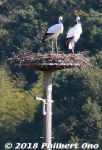
Two Oriental white storks on a nesting platform. Each nesting platform has a video camera monitoring it 24/7 especially during the egg-laying and hatching season in spring.The park is likely crowded during this time until the babies leave the nest in June/July.
|
|

Oriental white stork nests are large, about 2 meters diameter, made of tree branches and straw.
|
|

Back inside the Oriental White Stork Culture Center. On the left is the European white stork with a red bill, on the right is the Oriental white stork with a black bill. Very similar.
|
|

The hanafuda card with the "crane" is actually an Oriental white stork. It actually looks like a cross between the two birds...
|
|

Exhibits.
|
|
|
|
|
|
|
|
|
|
|

Screening room.
|
|

Aquariums with fish.
|
|

Even insects.
|
|

Part of the park is a large biotope used as a stork sanctuary and research facility. Only part of it is open to the public.
|
|
|

Nesting platform.
|
|

About the biotope.
|
|

Large biotope used as a stork sanctuary and research facility.
|
|

Park's website: http://www.stork.u-hyogo.ac.jp/en/
|
|

Gift shops in this building next to the parking lot.
|
|

Confection shaped like stork eggs.
|
|

Oriental White Stork manhole in Toyooka, Hyogo Prefecture.
|
|

Oriental White Stork manhole in Toyooka, Hyogo Prefecture.
|
|

Airline with a plane donning an Oriental White Stork motif.
|
|
|
|
|